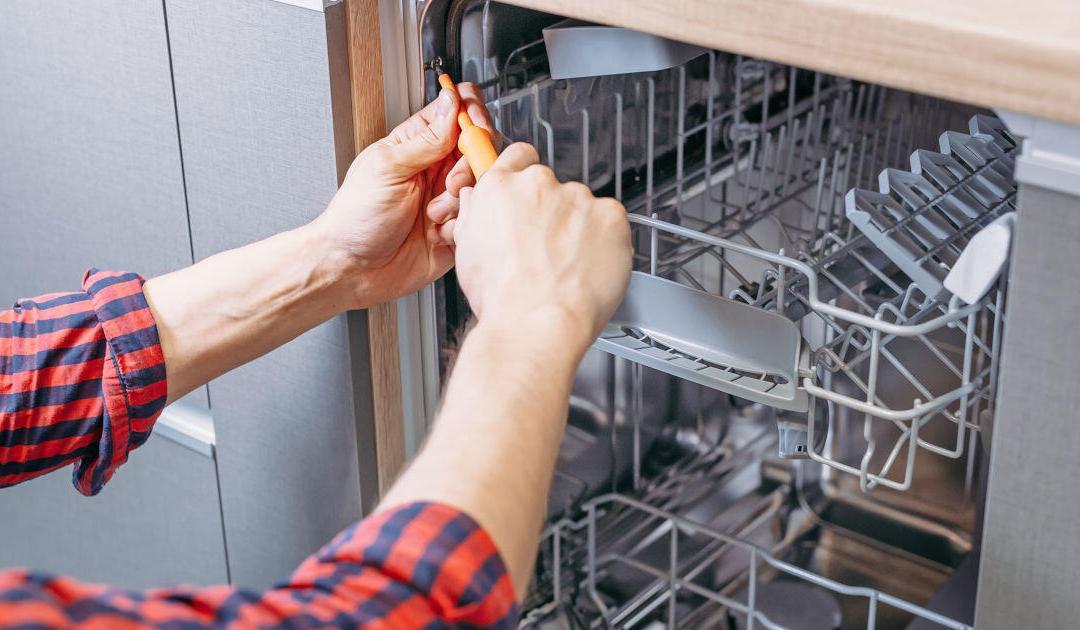Installing a dishwasher in a new home construction requires a lot of delicate plumbing and electrical work that’s best left to professionals. But if you’re just replacing your old dishwasher with a new model, most of the work is already done. Here’s what’s left to do.
Remove your old dishwasher
Before doing anything else, read your owner’s manual. Some dishwasher models have additional parts or special instructions you need to follow when disconnecting them.
- Turn off the matching breaker on the electrical panel to cut off the power, as well as the water shut-off valve under the sink.
- Remove the dishwasher’s front access panel.
- Disconnect the old electrical wiring.
- Place a shallow container or a towel under the supply and drain fittings before disconnecting the pipes to catch any water spills.
- Unscrew the mounting brackets that secure the dishwasher to the cabinet or countertop.
- Slide a blanket or a large piece of cardboard under the legs of your old dishwasher before removing it from its location, to avoid damaging the floor.
Prepare your new dishwasher for installation
Check the owner’s manual for your new dishwasher: some manufacturers have specific instructions that may differ from the general advice below. Then carry out the following steps before sliding your new dishwasher into place, while certain parts are easier to access.
- Remove the front access panel.
- Connect the 90-degree elbow fitting to the water valve, following the instructions in your owner’s manual.
- Replace the old water supply and drainage pipes with new ones.
- Ensure that the drain pipe is positioned higher the drain outlet, to prevent any backflow.
- Temporarily tape the pipes to the floor to prevent them from shifting as you slide the dishwasher into place.
We strongly recommend changing your hoses for new ones every five years, so replacing your dishwasher is the perfect time to do so. For increased durability, opt for braided metal hoses.
Connecting your new dishwasher
Once again, use a blanket or a large piece of cardboard to avoid damaging the floor as you push your dishwasher into place.
- Connect the water supply hose to the 90-degree elbow fitting. Use pliers to ensure a tight seal.
- Open the water shut-off valve under the sink and check for leaks.
- If there’s no such valve, we recommend having one installed by a plumber. This will enable you to react more quickly in the event of a leak to limit water damage.
- Connect the drain hose and wiring as described in your owner’s manual.
Finalize your dishwasher installation
You can now restore power to the electrical panel, and your dishwasher is operational! The final steps are designed to ensure a safe installation and ideal performance for your appliance.
- Make sure that the dishwasher is level for proper drainage. If necessary, adjust the levelling feet at the front.
- Secure the dishwasher to the cabinet or countertop using mounting brackets. This is an often overlooked step that prevents the dishwasher from tipping over if the door is opened suddenly or if the top rack is heavily filled.
- Replace the front access panel.
- To prevent water damage, you should always be present when your dishwasher is running. This is especially the case when you run it for the first time!
Need dishwasher parts?
Installing a new dishwasher is the perfect time to replace some worn parts with new ones that may not be included with your unit, such as the feed hose or some fittings. To ensure you buy the right replacement part, contact our team. Our specially trained staff will advise you, identify the exact part you need, and if necessary, have it shipped to your home.
Order your parts online
